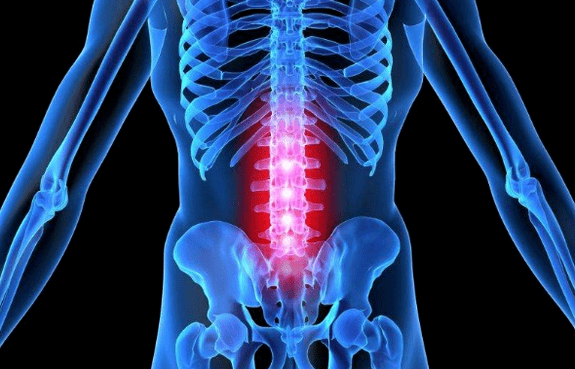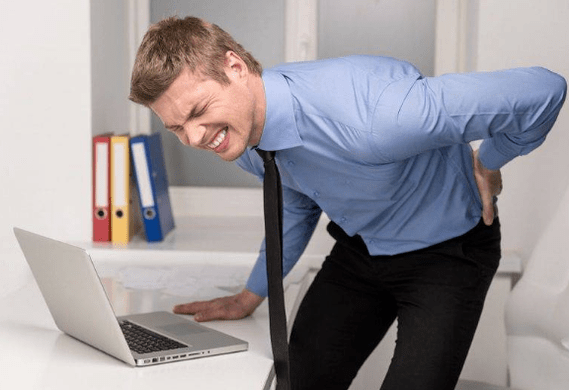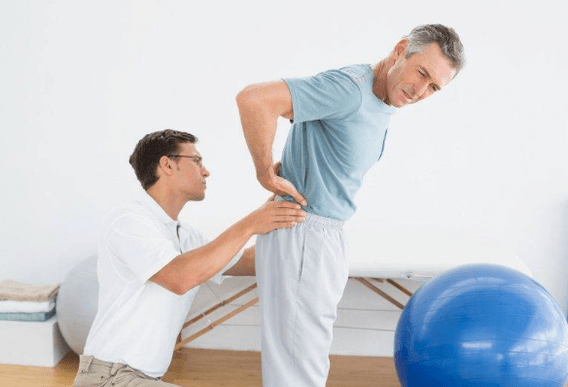Pain in the lower back most often affects people after 35 years.In the vast majority of cases, the disease is associated with deformity of the vertebrae and its consequences.The timely appeal to the doctor will accelerate recovery because the symptoms and treatment of lumbar spine osteochondrosis are interconnected concepts.

The greater the progression of the disease, the more serious its consequences, the more difficult is the process of restoring health.
Signs and symptoms of lumbar spine osteochondrosis
The lumbar region is located between the Sacrum and the chest department and consists of five beads associated with intervertebral discs.
The development of osteochondrosis implies the wear of the intervertebral discs that perform a role that adheres to shock in the back.The discs of the disks are a gel -like mass, protected by a dense fibrous ring and cartilage, and the inner space is filled with a liquid pulposa core.
While the loads on the vertebrae, the elasticity and flexibility of the intervertebral discs are lost, are lost, as their height, and the micrococks form in the fibrous ring, which over time leads to its rupture and damage to the pulpica core.
Tissue destruction is accompanied by a nerve root pliers located on both sides of the vertebrae and causes severe pain.
The main signs of lumbar osteochondrosis:
- back pain;
- fatigue and depression;
- excessive muscle weakness or tension;
- loss of sensitivity in limbs, buttocks or hips;
- Acute or painful pain and spasms in the lower back, often giving to the feet;
- Violation of motor function.
Despite the backdrop of serious vertebral lesions, other symptoms are also observed in the lumbar region, most often, dysfunction of other organs - urinary and sexual system, gastrointestinal tract.
Causes
Like most diseases of the muscular system, osteochondrosis can develop for many reasons.Some of them lie in the lifestyle and diet, the rest develops against the background of the physiological characteristics of the body.
Very often, the treatment of lumbosacral spine osteochondrosis is required by athletes whose back is subject not only to constant energy loads but also by periodic damage.
The second category of people who are in danger, people who, because of their profession, spend a lot of time in a position - teachers, hairdressers, chefs, loaders, waiters, programmers, office workers and drivers.
Among other causes of pathology development:
- Excess weight;
- violation of metabolism;
- improper behavior, stoop;
- genetic predisposition;
- injuries;
- bad habits;
- Lack of beneficial elements of traces and vitamins in the diet;
- Abnormal development of the muscle bone system, flat feet;
- hypothermia;
- sedimentary, static;
- Frequent stresses.
All the factors listed can affect the elasticity of intervertebral discs, as they contribute to violations of blood circulation or the appearance of a nutrient deficiency that enter the vertebrates.
The degree of osteochondrosis of the spine
Depending on the level of spinal cord damage, the four degrees of development of osteochondrial processes, manifested in stages as the disease develops, are distinguished.
First degree.
The pathological processes in the back begin long before their first clinical manifestation.As a result, moisture losses, the intervertebral discs become less elastic elastic.Disk height is maintained normal.The patient feels discomfort in the lower back.
Second degree.
Against the backdrop of moisture deficiency, the microcts appear in the fibrous ring and the inflammation of the tissues develops.The beads of the vertebrae gradually increase.There are seals in the cartilage.The patient complains of pain in the back, giving his feet or groin.It is possible to limit motor skills.In the work of the internal organs, failures occur.
Third degree.
The integrity of the fibrous ring is disturbed, the intervertebral disk that is removing, forming a hernia.The vessels and nerve endings are compressed.Muscle spasms, pelvic organs dysfunction, a disorder of the sensitivity of the lower extremities, prolonged radiculitis attacks.
Fourth degree.
The most complex phase, not suitable for treatment, phase during the disease.As a result of the complete destruction of the intervertebral discs, the wounds form in their place.The vertebrae are maximally close and gradually deform.With the development of compression of the spinal cord, the paralysis of the lower extremities is possible.
Troubleshooting
To know the disease and determine the correct diagnosis, neurologists use a complex of measures - a history of anamnesis, physiological examination and hardware studies.

The dependent collection.
Provides patient complaints study:
- the cause of anxiety;
- the location of the discomfort;
- duration and intensity of unpleasant sensations;
- duration of the disease;
- possible causes of the disease;
- frequency of irritation;
- factors that provoke irritations;
- Factors that improve well -being.
Moreover, the doctor studies information on the patient's lifestyle, diet, work and rest, the presence of bad habits, hereditary factors and damage.
Physiological examination.
Is performed to determine pathological changes and make a preliminary diagnosis.
During the examination, the doctor evaluates the patient's motor skills - walking, behavior, amplitude and volume of movements.The palpation method examines the muscle condition - tone, size, volume of spasms.Using small tingling sensations, it sets the sensitivity level.Touching with a hammer makes it possible to detect the pain radiation area.
Hardware
To obtain complete and accurate information about the location of the pathology and degree of tissue lesions, doctors use research through different types of medical equipment.
Radiography.Studying the lumbar region through an X -Ray allows us to create anatomical parameters of vertebrae and intervertebral discs, the tendency to narrow the holes between the bases, the presence of bone growth.
Tomography.The use of electromagnetic waves ensures the production of the image of the studied area on the screen for study and further analysis of the blood vessel condition that feeds the spine tissue, nerve processes and intervertebral discs.
c TPictures of some spinal segments are performed using an X -Ray radiation.The image appears on the monitor to determine the nature of the changes in the container, the membrane of the vertebrae and the spinal cord and the regional growth.
For differential diagnosis, different types of studies are used to eliminate the pathologies of other body systems.
Treatment of lumbosacral spine osteochondrosis
The duration and features of the treatment of lumbosacral osteochondrosis depend on the results of the diagnostic measures.In the early stages of the development of the disease, conservative treatment is indicated.With more complex spinal lesions, surgical intervention is used.
The optimal therapeutic effect is achieved through complex therapy, which provides for the use of local drugs, physiotherapy, massage and healing gymnastics.
Treatment
To relieve symptoms, non -steroidal medicines for internal and external use are prescribed - tablets, injections, ointments.Moreover, chondroprotectors, neuroprotectors, diuretics, vitamins, muscle relaxants are used.
Drug treatment allows:
- eliminate pain;
- remove inflammation;
- Relax the muscles;
- reset the destroyed cartilage fabric;
- improve blood circulation;
- reduce swelling;
- increases physical activity;
- Normalize brain food.
In acute pain, Novokaine blockades that provide an immediate effect.
Folk remedies
Popular method treatment is effective as an additional medicine therapy.The main techniques of traditional medicine are based on the use of plant materials, animal products and chemicals.
Based on various components, ointments and compresses, decoctions and infusions are prepared for internal and external use, as well as for therapeutic baths are prepared.
Physiotherapy for lumbar osteochondrosis
Physiotherapeutic procedures are a great way to restore motor functions of the spine after damage to osteochondrosis.
The main physiotherapeutic methods include:
- Electrotherapy - exposure to weak electrical currents to increase blood circulation in the tissue;
- Magnetotherapy - the use of magnetic fields to restore tissues at the cellular level;
- Laser therapy - comprehensive activation of biological processes in vertebrates and nerve endings;
- Shock wave therapy-an improvement in microcirulation and metabolic processes in tissues affected by the effect of an acoustic wave;
- Balneotherapy - the use of healing properties of mineral water.

Physiotherapeutic procedures not only increase the effectiveness of medication treatment several times, but also contribute to the healing and strengthening of the body as a whole.
Massage for Lumbari's osteochondrosis
Visit massage procedures are one of the most pleasant and effective methods of treating osteochondrosis.
Using therapeutic massage:
- eliminate muscle cramps;
- improve blood supply to the affected areas;
- improve lymph flow;
- restore muscles that have exposed atrophy;
- Remove the restriction of mobility.
Massage is described when pain syndromes are eliminated.
Therapeutic
The main task of exercising therapy for osteochondrosis is to restore the functionality of the spine and its correction.However, you can only participate in classes after eliminating the symptoms of irritation.
The most effective methods of therapeutic exercises are considered:
- charger;
- visiting the gym;
- Water therapy, swimming.
At home, you can use a stake for sports.Some doctors to restore spine flexibility recommend yoga lessons for their patients.
Excessive osteochondrosis exercises
Anydo exercise for osteochondrosis should be performed slowly and without sudden movements.
To strengthen the muscles that support the vertebrae, approaching the exercises performed lying in the stomach.In this case, the hands are stretched with a slight sip, but without tension.Repeat 4 times.
Surgical intervention
They use the treatment of the spine in particularly difficult cases - with significant neurological disorders, as well as in the event of loss of control over intestinal movements.
During surgical intervention, the removal of the source of the disease is ensured, and the masses are performed to stabilize the spine.The post -surgery period lasts several months.
Why is lumbar osteochondrosis dangerous?
Degenerative changes that occur with lumbar osteochondrosis contribute to the development of many diseases dangerous for human life.Against the backdrop of intervertebral hernia, extension, lumbago and Ishias.
Further progression of the disease can cause a decrease from the intervertebral disc and the formation of spinos.In addition to pathologies that accompany severe pain, a person's motor skills are violated, until their full loss.Paralysis of the lower extremities develops.
With significant damage to the spinal cord membrane, death is inevitable.
PREVENTION
To avoid devastating changes in your back, you need to take care of a healthy lifestyle:
- do sports - swimming, strengthening;
- Respect the proper balanced, good food;
- exclude bad habits;
- keep behavior;
- Support the spine during sleep using an orthopedic mattress.
In addition, it is advisable to avoid hypothermia, weight lifting.Women are not recommended to wear high behavior shoes often.
You can maintain lumbar health if you adjust your lifestyle and don't forget about the importance of physical activity.


















